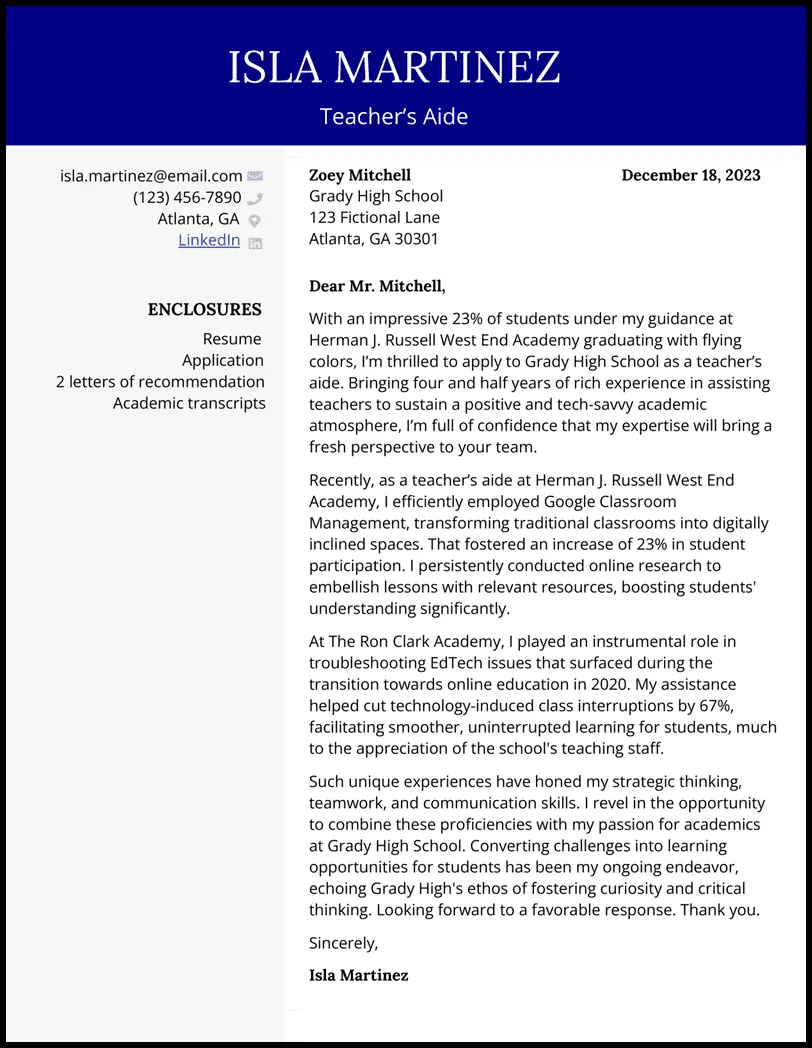What is a Paraprofessional Cover Letter?
A paraprofessional cover letter is a crucial document that accompanies your resume when applying for a paraprofessional position. It serves as your first introduction to a potential employer, allowing you to showcase your personality, skills, and enthusiasm for the role. Unlike a resume, which provides a factual overview of your experience and qualifications, a cover letter provides an opportunity to elaborate on your suitability for the specific job and explain why you are the ideal candidate. It demonstrates your written communication skills and allows you to highlight your key strengths and how they align with the requirements of the position. When applying for entry-level roles, the cover letter becomes even more important as it provides context to your limited experience and explains your career goals.
Why is a Cover Letter Important
The importance of a cover letter cannot be overstated, especially for entry-level paraprofessional positions. It provides an opportunity to personalize your application and demonstrate genuine interest in the role and the school or district. Hiring managers often use cover letters to assess a candidate’s communication skills, attention to detail, and understanding of the job requirements. It allows you to connect your skills and experiences to the specific needs of the position, demonstrating that you have researched the role and understand what the employer is looking for. In a competitive job market, a well-crafted cover letter can set you apart from other applicants and increase your chances of getting an interview. It is a chance to make a positive first impression and make your case for why you should be considered for the position.
Key Elements of a Paraprofessional Cover Letter
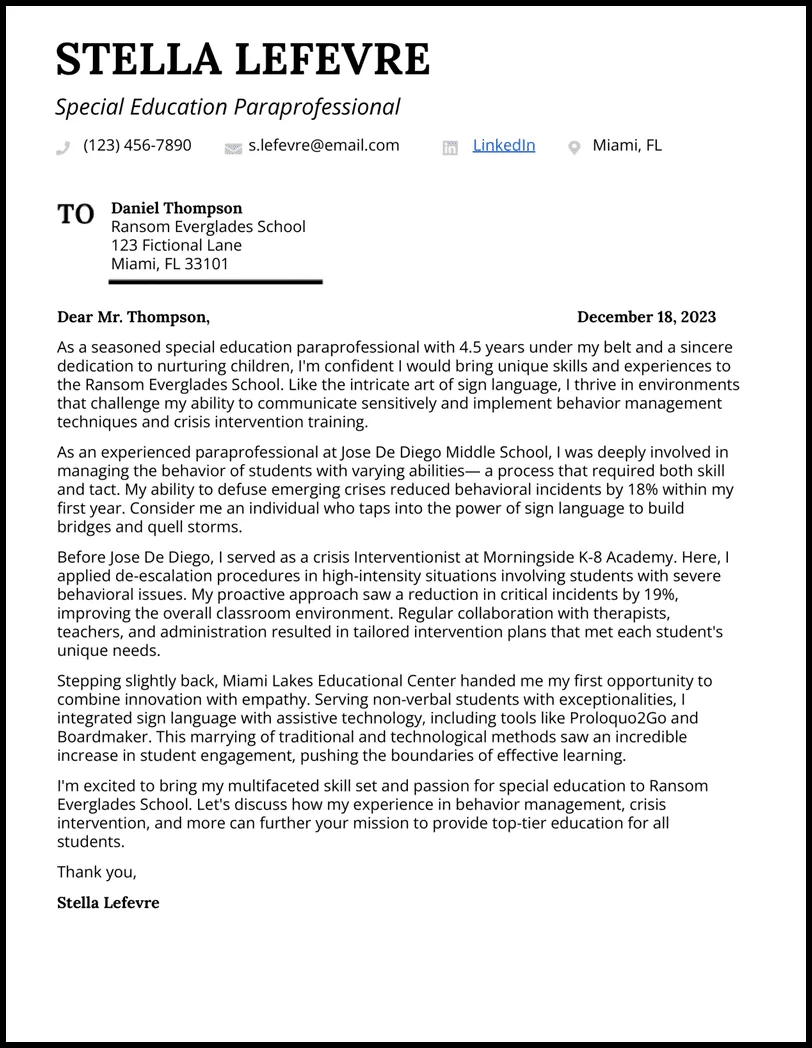
A strong paraprofessional cover letter includes several key elements. These elements work together to create a compelling narrative that showcases your skills, experience, and enthusiasm. The organization and structure of your cover letter are just as important as the content, which can be achieved through the careful use of sections and paragraphs, ensuring that the information is easy to read and understand. You should also make sure to avoid any grammatical errors or spelling mistakes to avoid making a negative first impression. By focusing on the key elements outlined below, you can create a cover letter that effectively communicates your qualifications and increases your chances of securing an interview.
Contact Information
Your contact information should be the first section of your cover letter. This ensures that the hiring manager can easily reach you. Make sure to include your full name, address, phone number, and email address. Ensure that the email address is professional, avoid nicknames or informal language. If you have a professional online presence, such as a LinkedIn profile, you can also include the URL.
Your Name and Contact Details
At the top of your cover letter, start with your name, full address, phone number, and email address. This information should be clearly displayed and easy to find. Using a standard format, such as left-alignment or a header, will make your contact information readily accessible. Double-check all the details to avoid any errors.
Date and Recipient Information
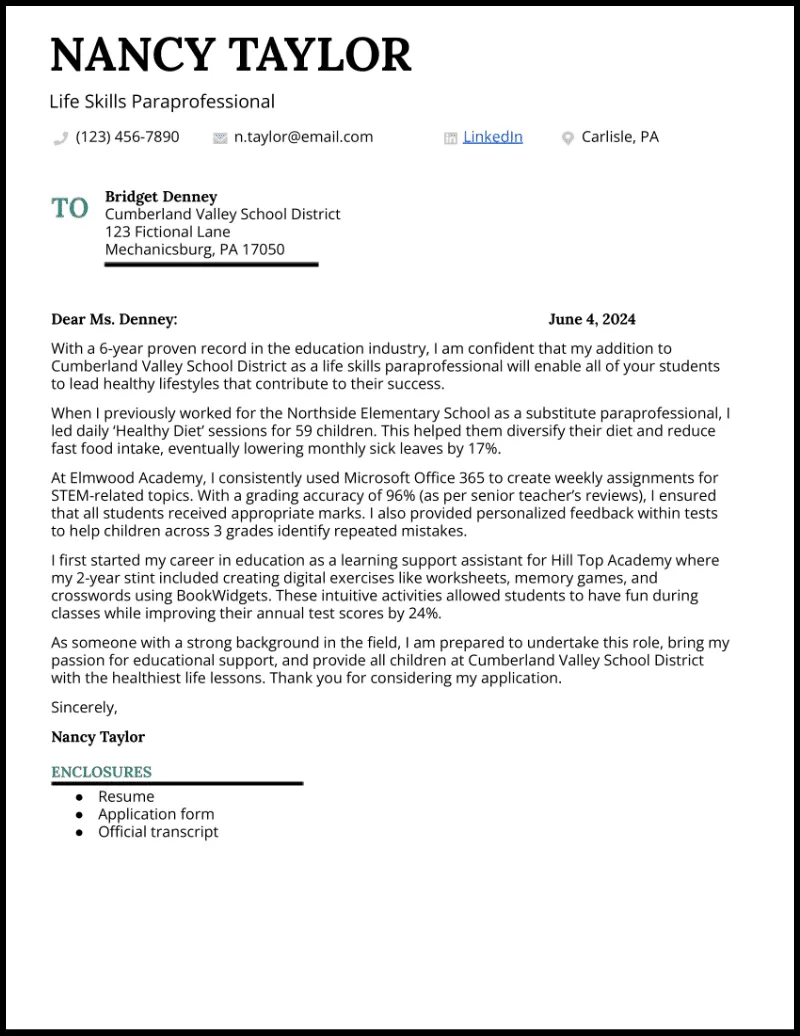
Following your contact information, include the date you are sending the letter. Then, include the recipient’s information. If you know the hiring manager’s name, use it; otherwise, use the title of the person responsible for hiring (e.g., ‘Hiring Manager’). Include the recipient’s title, the school/district name, and the address. Always double-check the accuracy of this information to show your attention to detail.
The Salutation
The salutation sets the tone for your cover letter. Use a formal salutation, such as ‘Dear Mr./Ms./Mx. [Last Name],’ if you know the hiring manager’s name. If you are unsure, use ‘Dear Hiring Manager.’ Avoid informal salutations like ‘To Whom It May Concern,’ as they can appear impersonal. Always spell the name correctly and check the gender of the recipient to avoid any awkwardness.
Writing the Body of Your Cover Letter
The body of your cover letter is where you make your case for why you are the best candidate. This section is typically divided into several paragraphs, each focusing on a specific aspect of your qualifications and your suitability for the role. The content of your cover letter should be specific to the job. Avoid generic statements and instead, tailor your letter to the specific requirements of the position, highlighting how your skills and experiences align with the employer’s needs. The body should be well-organized, easy to read, and free of jargon. It is also important to maintain a positive and enthusiastic tone throughout the body of your cover letter.
Highlighting Your Skills and Qualifications
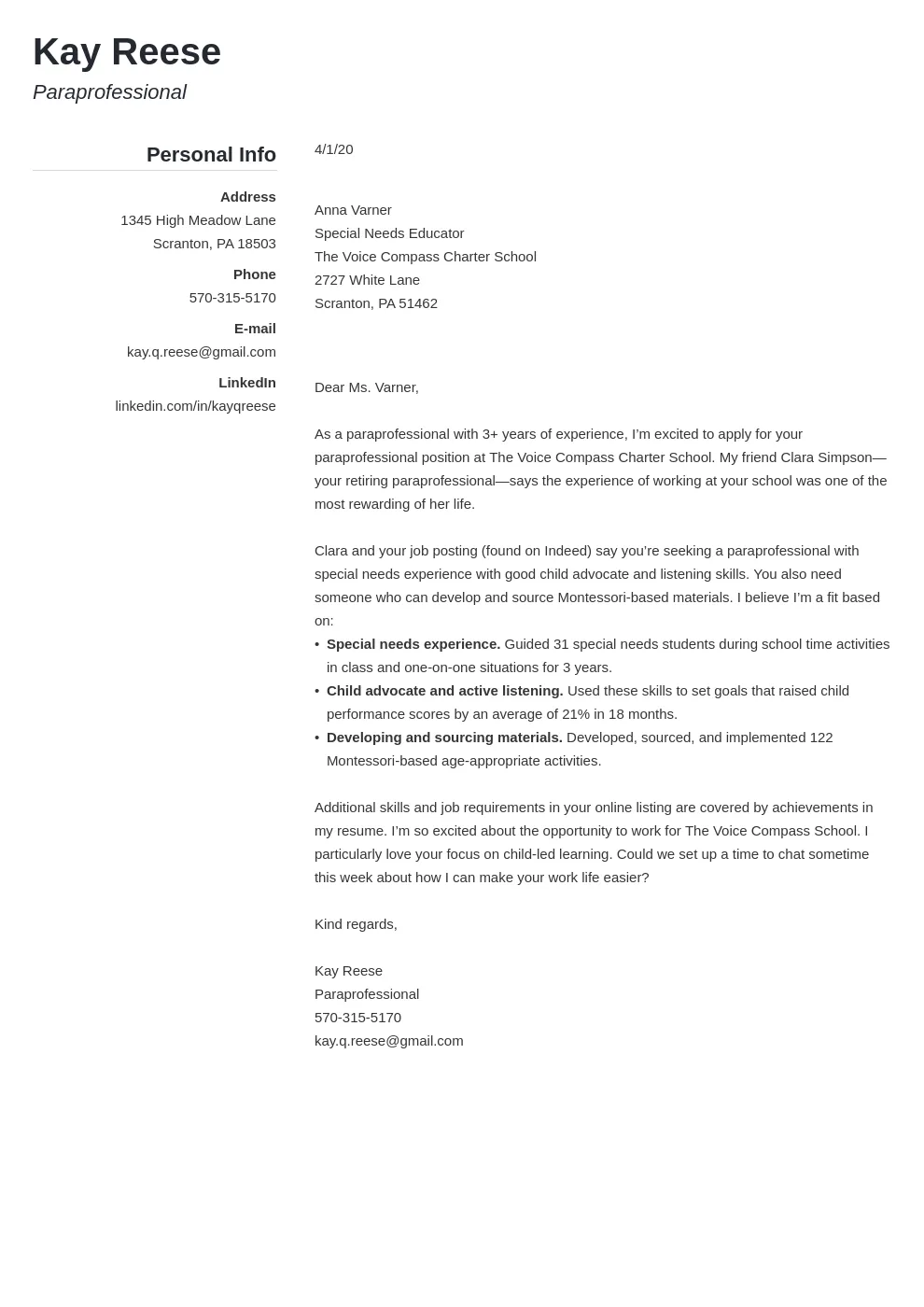
The primary goal of your cover letter is to highlight the skills and qualifications that make you a strong candidate. Identify the key skills required in the job description. Examples of skills commonly sought include communication, classroom management, patience, and the ability to work with children. Elaborate on your skills by providing concrete examples of how you have utilized them in the past. If the job description mentions specific software or equipment, be sure to mention any experience you have in this area.
Showcasing Relevant Experience
Even if you are an entry-level candidate, you likely have relevant experience. This might include volunteer work, internships, or part-time jobs. When describing your experience, focus on the skills you developed and how they relate to the paraprofessional role. Always provide concrete examples of your accomplishments, highlighting the positive impact you made in previous roles. If you lack direct experience, focus on transferable skills, such as communication, teamwork, or problem-solving abilities.
Tailoring Your Letter to the Job Description
Customizing your cover letter is crucial for demonstrating your interest in the specific position. Carefully review the job description and identify the key requirements and qualifications. Throughout your cover letter, demonstrate how your skills and experiences align with these requirements. Do not simply rehash your resume; instead, provide additional context and expand on your accomplishments. By tailoring your letter, you show the hiring manager that you understand the role and are genuinely interested in the position, which increases your chances of getting an interview. Use keywords from the job description to show that you understand the position’s needs.
Quantifying Achievements
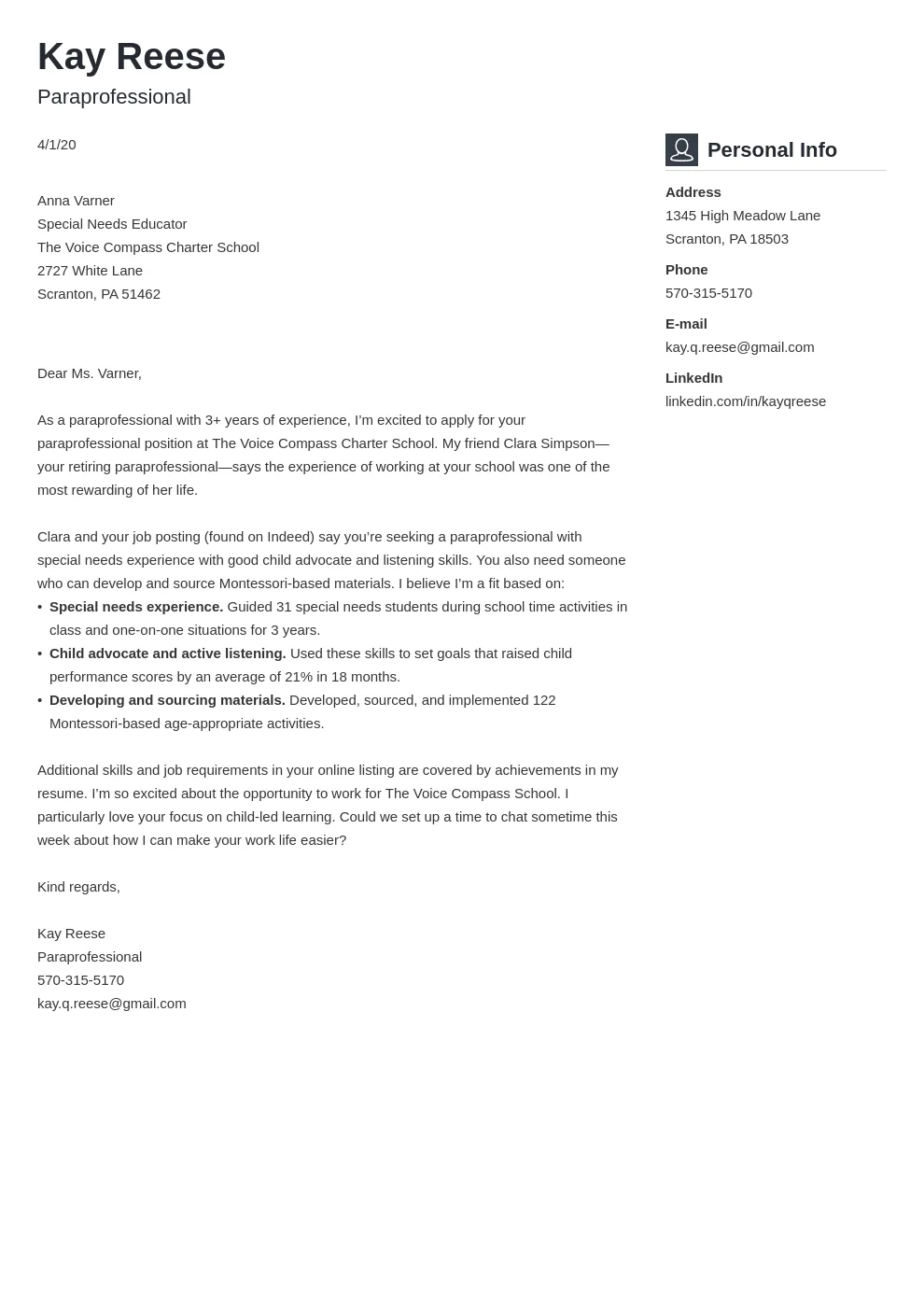
Whenever possible, quantify your achievements to make your cover letter more impactful. Instead of simply stating that you ‘assisted students,’ provide specific examples of your accomplishments. For example, you might say, ‘Assisted in the development of individualized education plans (IEPs) for 15 students.’ By using numbers and data, you provide concrete evidence of your skills and abilities. These details allow the hiring manager to understand the scope of your impact and accomplishments.
Expressing Enthusiasm
Your cover letter is an opportunity to express your enthusiasm for the position and the school district. Convey your passion for working with children and your commitment to supporting their educational journey. Use positive language and avoid sounding generic or uninspired. It is important to demonstrate your interest in the specific school or district, showing you have researched the institution and understand its mission and values. Personalize your letter to show why you are a good fit for the organization. You can also make a connection between the school’s mission and your career goals.
Using Action Verbs
Use strong action verbs to make your cover letter more engaging and dynamic. Start each bullet point or sentence with an active verb that highlights your achievements and responsibilities. By using action verbs, you can convey a sense of confidence and competence, and you will be able to effectively communicate your skills and experience. Avoid passive language, such as ‘was responsible for.’ Instead, use verbs such as ‘managed,’ ‘coordinated,’ ‘implemented,’ ‘supported,’ or ‘collaborated.’ These verbs can add a more dynamic touch to your accomplishments.
The Closing
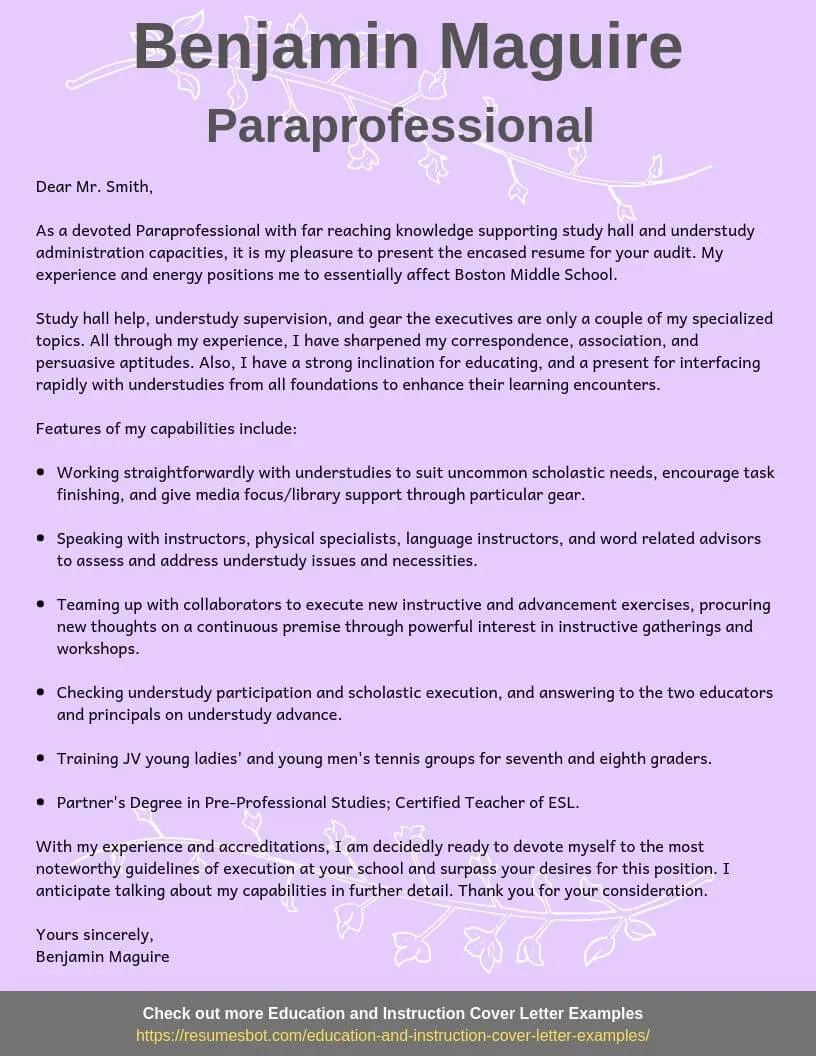
The closing of your cover letter is the final impression you make on the hiring manager. It should be professional, concise, and express your interest in the position. End your letter by thanking the hiring manager for their time and consideration. State your availability for an interview and reiterate your contact information.
Proper Formatting and Proofreading
Proper formatting and careful proofreading are essential components of an effective cover letter. Formatting creates a professional and organized appearance, while proofreading ensures that your letter is free of errors. Errors can damage your credibility and make it less likely that your application will be considered. These steps are important to enhance the readability and effectiveness of your cover letter, making a strong positive impression on the hiring manager.
Formatting Guidelines
Use a professional font, such as Times New Roman, Arial, or Calibri, in a standard size (11 or 12 points). Maintain consistent formatting throughout the document, including font style, spacing, and alignment. Use single-spacing within paragraphs and double-spacing between paragraphs. Use a clean and clear layout. Make sure the letter is easy to read and visually appealing. Organize the content into logical sections with clear headings and subheadings.
Proofreading and Editing
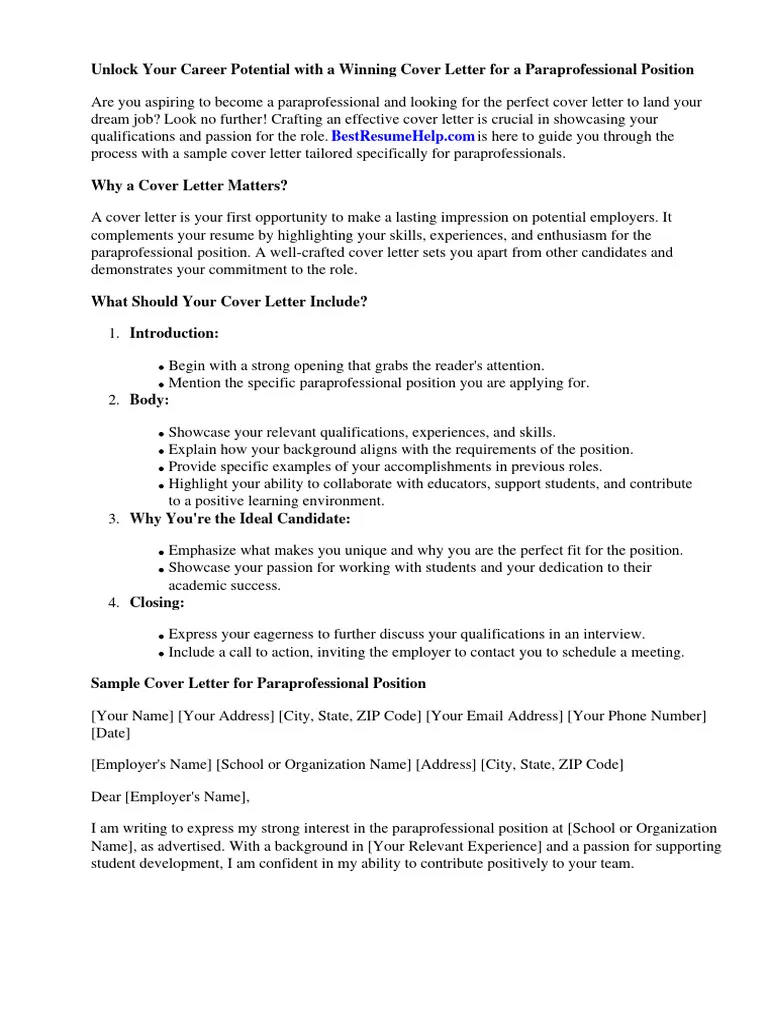
Carefully proofread your cover letter for any grammatical errors, spelling mistakes, and typos. Read your letter multiple times, ideally at different times of the day, to catch any mistakes. Use a grammar and spell-checking tool, but do not rely on them solely. Have a friend, family member, or career counselor review your cover letter for feedback. Proofreading will enhance your credibility, and it will allow you to ensure your cover letter is error-free and reflects your best qualities.
Examples of Entry Level Paraprofessional Cover Letters
Reviewing examples of entry-level paraprofessional cover letters can provide valuable guidance. It can help you understand the key elements, the structure of the letter, and the tone. Examples provide a visual guide for formatting. Adapt the examples to fit your personal circumstances and the specific job description.
Example 1 Skills Focused
This type of cover letter emphasizes the skills you have to offer. It is especially useful if you have limited experience but possess skills that align with the job description. This letter format uses the STAR method, which stands for Situation, Task, Action, and Result, in the body to showcase your achievements in a clear and concise way. Make sure to highlight your skills and back them up with the examples.
Example 2 Experience Focused
When you have some relevant experience, a cover letter focused on this can be a strong way to highlight your accomplishments. This type of letter emphasizes your past experiences and how they have prepared you for the role. The experience-focused cover letter is a great option to show your achievements. Provide concise details about your responsibilities and accomplishments, showing how your skills and experiences align with the job description.
Common Mistakes to Avoid
There are several common mistakes to avoid when writing an entry-level paraprofessional cover letter. Being aware of these errors can help you create a more effective and professional application. Avoid mistakes to increase your chances of getting an interview.
Generic Cover Letters
Avoid sending generic cover letters that are not tailored to the specific job. Generic cover letters are usually the same for different jobs, and they do not highlight the candidate’s interest or qualifications. Always tailor your cover letter to the specific job description and the school or district you are applying to. Research the school and its values and tailor your letter accordingly.
Typos and Grammatical Errors
Typos and grammatical errors can damage your credibility and make a negative impression. Always proofread your cover letter carefully before submitting it. Use a grammar and spell-checking tool, and have someone else review it for errors. These errors show a lack of attention to detail and can make you appear unprofessional.
Not Tailoring to the Job
Failing to tailor your cover letter to the job description is a major mistake. The job description indicates the needs of the employer, and it is very important that you address the specific requirements in your cover letter. Highlight your relevant skills and experiences that align with the job requirements. Use keywords from the job description to show you understand the position’s needs. Demonstrate your understanding of the role and why you are a good fit for the position.
Final Tips for Success
Creating a compelling cover letter requires careful planning, writing, and attention to detail. By following these final tips, you can increase your chances of making a positive impression on the hiring manager and securing an interview. Consider these tips to create a compelling cover letter and get hired.
- Research the school or district
- Highlight your relevant skills and experiences
- Quantify your achievements whenever possible
- Proofread carefully
- Get feedback from others
